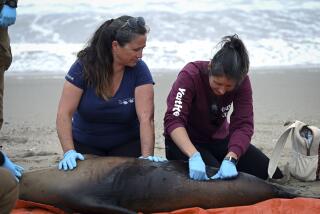Unlucky Tasmanian devils suffer not one, but two kinds of transmissible cancer
Tasmanian devils are an improbably unlucky species.
First, they are nearly wiped out by an unusual cancer that spreads when the fierce marsupials bite one another in the face. And now, scientists have discovered a second transmissible cancer that spreads the same way.
The revelation suggests that transmissible cancers, thought to be rare in nature, may occur more often that scientists previously thought, according to a recent study in Proceedings of the National Academy of Sciences.
“Until a couple years ago, there were only two transmissible cancers known in the natural world,” said Greg Woods, an immunologist at the University of Tasmania on the Australian island and a joint senior author of the study. “Maybe transmissible cancers have occurred in the wild before and we didn’t notice it because we weren’t looking for it.”
Aside from the tumors plaguing Tasmanian devils, the only known transmissible cancers in animals are canine transmissible venereal tumor and disseminated neoplasia in soft-shell clams.
All of these diseases originated in a single “founder animal” whose cells became cancerous and found a way jump to other individuals in order to survive.
Devil facial tumor disease, or DFTD, was first spotted in 1996 in northeast Tasmania. As it spread throughout the island, it caused the number of Tasmanian devils to plummet by more than 80% and landed the species on the International Union for Conservation of Nature’s endangered list.
With jaws that can pierce bone, the scrappy Tasmanian devil is known to bite other devils on the face during mating and feeding. The disease spreads when cancerous cells from an infected devil enter the bitten animal’s wound. A healthy devil could also contract the disease by biting an infected devil’s tumors.
Once the tumors spread across the face and mouth, the animal can starve to death within months.
Scientists from the University of Tasmania thought they were dealing with DFTD in 2014 and 2015 when they investigated reports of infected animals in the D’Entrecasteux Channel area, a small peninsula in the island’s southeast.
On the outside, the familiar-seeming tumors ranged in appearance from small spots in the mouth or skin to masses that caused facial deformities.
But in the lab, “they just looked different,” Woods said.
Under the microscope, DFTD cells are round and arrange themselves in distinct cords or packets. These cells had no such shape and arranged themselves in sheets.
Genetic analysis showed the new tumor carried a Y chromosome, so it must have originated in a male devil. DFTD originated in a female.
Dubbed DFT2, the new cancer has only been detected in eight devils – seven male and one female. The researchers are still unsure of the disease’s prevalence and precise origins.
They suspect, however, that both tumors share a common lineage in the peripheral nervous system, first becoming cancerous in the cells that wrap around nerve fibers. That would explain why DFTD and DFT2 involve similar symptoms and behavior.
Both cells “spontaneously arose in an otherwise healthy devil and then got transmitted,” Woods said.
How did the Tasmanian devil get so unlucky?
For a cancer to spread from one individual to another, it needs both a mechanism to do so and a way to survive in its new host. In Tasmanian devils, it has both.
The tumor cells grow in the face, so when devils bite one another’s faces, those cancerous cells are getting transplanted right where they want to be.
Due to isolation and hunting by European settlers, Tasmanian devils lack the genetic diversity that would help protect them from an outbreak.
Conservation programs such as Save the Tasmanian Devil are building “insurance” colonies of healthy devils, which could someday be used to repopulate the island. The San Diego Zoo, home to four devils, and the Los Angeles Zoo, home to two brothers, both work with the program.
The ultimate goal, Woods said, is to develop a vaccine. Early efforts have seen some success, and scientists have been able to re-release some inoculated devils back into the wild.
Fortunately, the vaccine is likely to protect against both forms of DFTD due to the cancers’ parallel cellular lineages.
“We don’t have to go back to basics,” he said. “It’s a minor hurdle.”
Follow me on Twitter @seangreene89
MORE SCIENCE NEWS
12 amazing science stories we can’t wait to follow in 2016
The smaller the chameleon, the quicker the tongue, study finds
It’s official: Four super-heavy elements to be added to the periodic table







